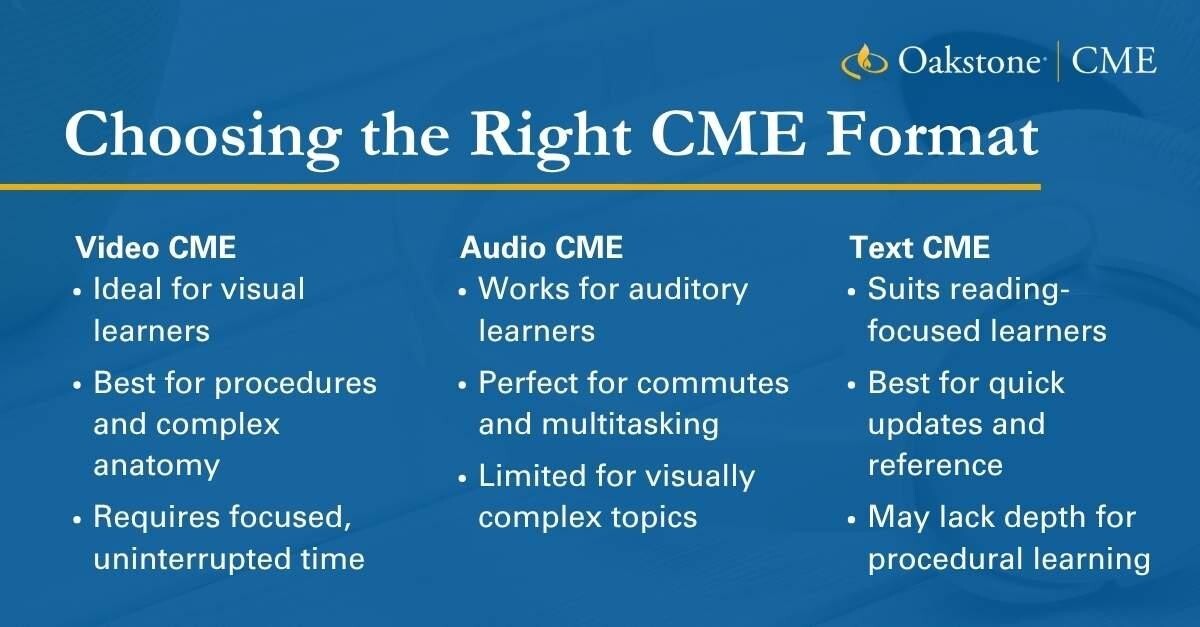Video CME vs. Audio CME vs. Text CME: Which is Right for You?

Continuing medical education (CME) comes in multiple formats, each suited to different learning contexts and clinical workflows. Format choice affects learning efficiency and retention.
Consider three common scenarios: you have 10 minutes between patients before the next appointment, you're stuck in traffic during your commute, or you're finally sitting down after a long shift with enough energy for focused study. Each demands a different CME approach, yet most clinicians default to whatever format is easiest rather than most effective.
Studies show that time remains the most significant barrier to CME completion, with over 80% of physicians citing lack of protected time and busy clinic schedules as primary challenges. When CME format aligns with learning preferences and fits into available time, both satisfaction and knowledge retention improve markedly. CME programs designed for flexibility and modular access report satisfaction rates of nearly 90%.
This guide examines the strengths and limitations of each format to help you match CME approach to workflow.
CME Format Comparison at-a-Glance
The table below provides a quick comparison of video, audio, and text CME formats across key factors that influence effectiveness and practical use.
|
|
Video CME |
Audio CME |
Text CME |
|
Primary Strength |
Visual demonstration with expert narration |
Fits into existing time without screen requirements |
Fast, searchable access to information |
|
Learning Style |
Visual and auditory learners |
Auditory learners |
Reading-focused learners |
|
Time Requirement |
Dedicated, uninterrupted blocks |
Flexible; multitasking compatible |
Brief intervals (5-10 minutes) |
|
Technology Needs |
Stable internet, compatible devices |
Mobile device with audio capability |
Basic device; minimal connectivity |
|
Best Topics |
Procedures, diagnostic interpretation, complex anatomy |
Conceptual updates, case discussions, evidence reviews |
Guidelines, protocols, rapid reference material |
|
Clinical Context |
Protected study time |
Commute, between shifts, downtime |
Between patients, rapid consultation |
|
Limitations |
Requires focused time; technical dependency |
Not suitable for visual content; distraction risk |
Limited depth; less effective for procedural topics |
Comparing CME Formats: Pros, Cons, and When to Use Each
You and your peers don't learn in the same way, and your CME format shouldn't assume you do. The right format can mean the difference between learning that sticks and time spent inefficiently.
Here's how to think about the three main CME formats—and which one serves your needs best.
Video CME: When Visual Learning Matters
CME videos excel at teaching what needs to be seen. Procedures, physical exams, diagnostic imaging, complex anatomical concepts all benefit from the combination of visual demonstration and expert narration. Research shows that visual and auditory learning together improve retention and helps clinicians translate knowledge into practice.
When video works best:
- You're learning procedural or technical skills
- Visual context is essential to understanding the topic
- You have dedicated time for focused, uninterrupted learning
- You prefer interactive, engaging content over passive reading
The tradeoffs: Video requires stable internet, compatible devices, and uninterrupted time. Poorly designed content risks passive consumption rather than active learning.
Audio CME: Learning on Your Terms
Audio CME fits into existing time—commutes, workouts, downtime—while reducing screen fatigue. For auditory learners, it can be highly effective.
When audio works best:
- You have regular commute time or downtime to fill productively
- You want to learn without screen time
- The topic doesn't require visual demonstration
- You prefer discussion, case reviews, or expert dialogue over written content
The tradeoffs: Audio can't teach what needs to be seen—anatomy, procedures, diagnostic images are difficult to convey through sound alone. Engagement can wane in distracting environments, and not all learners process spoken content equally well.
Text CME: Fast, Accessible, Practical
Text offers speed and control. You can skim for high-yield points, search for what you need, and reference materials instantly. For busy clinicians who want to learn in brief spurts or need quick access to evidence and guidelines, text CME is often the most practical choice.
When text works best:
- You need rapid updates or quick reference to guidelines
- You learn by reading and prefer to control your own pace
- You're between patients and have 5-10 minutes to learn something specific
- The topic is conceptual or evidence-based rather than procedurally visual
The tradeoffs: Text can lack depth and context when compressed into summary format. It's less effective for visual learners and topics requiring demonstration.
An effective CME strategy matches learning style and schedule to format, working with your workflow rather than against it.

The CME Challenge: Time, Preferences, and Real-World Barriers
Two factors consistently shape CME effectiveness: learning preferences and time constraints. Understanding both explains why format choice matters.
Learning Preferences Drive Outcomes
Research shows that when CME format aligns with a clinician's preferred learning style, satisfaction and retention improve significantly. Visual learners engage more deeply with video demonstrations. Auditory learners retain information better through discussion and expert dialogue. Reading-focused learners prefer text they can skim, search, and reference.
Adult learners are also more engaged when they control their learning experience. Flexibility—choosing video for complex procedures, audio for conceptual updates, text for quick reference—increases motivation and practical application of new knowledge.
The Time-Constraint Reality
Time remains the most significant barrier to CME completion, driving a shift from traditional conferences to on-demand digital formats. Clinicians complete most CME during off-hours to avoid compromising patient care. Brief, modular content and mobile access are now standard expectations.
Clinicians favor CME that integrates into existing time: bite-sized modules, audio for multitasking, searchable text for between-patient learning.
What Clinicians Need
When learning preferences and time constraints converge, the requirements become straightforward:
- Flexible formats that accommodate different learning styles
- On-demand access that fits unpredictable schedules
- Modular content that allows learning in brief intervals
- Mobile-friendly delivery for anytime, anywhere access
- Specialty-relevant material that applies directly to practice
CME that respects these realities—offering choice, flexibility, and efficiency—produces better engagement, higher satisfaction, and improved clinical outcomes.
Blending Formats for Maximum Flexibility
Most clinicians combine formats strategically based on immediate needs and available time. Use video during protected study time for complex topics, audio during commutes or between shifts, and text for rapid reference between patients. This adapts to context rather than forcing uniformity.
Practical Implementation
Effective blended CME requires minimal friction. Modular content allows completion in segments that match unpredictable schedules. Partial credit systems recognize learning in brief intervals rather than requiring lengthy sessions. Mobile access enables seamless transitions between formats based on context.
Integration with workflow tools—calendar reminders, automated credit tracking—reduces administrative burden and maintains visibility during busy clinical days without adding scheduling complexity.
How Oakstone Supports Your Learning
Oakstone provides comprehensive CME across video, audio, and text formats in more than 30 specialties.
Our video library includes specialty courses, board preparation, and case reviews. Audio products—including MKSAP, GRS, and SESAP Audio Companions—stream or download through mobile apps. Text-based modules, journal summaries, and reference materials provide rapid access to guidelines and evidence.
The platform supports modular learning with automated credit tracking, reducing administrative burden while maintaining flexibility across formats. Whether you're preparing for board certification, staying current on specialty updates, or seeking practical clinical guidance, content is accessible on-demand and compatible with mobile devices.
Your CME, Your Choice
Effective CME matches your learning style, schedule, and immediate needs. Oakstone provides the format flexibility and specialty-specific content to make efficient professional development possible within demanding clinical practice. Explore Oakstone's multi-format CME options.
